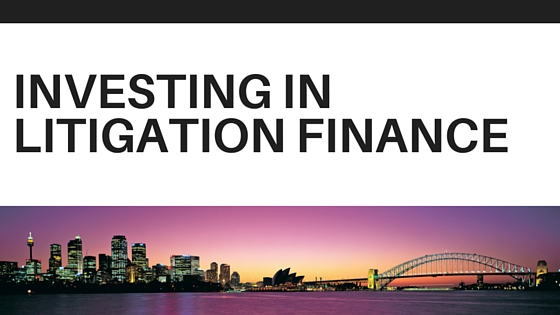Opening up access to new investors in litigation finance
Jay Greenberg is co-founder and CEO of LexShares, a new online investment platform for investing in litigation finance. While investing in legal claims has long been done, it hasn’t been easy for investors to get exposure to this asset class.
Tradestreaming recently discussed litigation finance with Jay and how different types of investors are turning to his crowdfunding platform of sorts to access investment opportunities.
What is litigation finance?

At its most basic level, litigation finance, also called litigation funding, is the practice in which a third party unrelated to a lawsuit provides capital to a plaintiff in return for a portion of any financial recovery from the lawsuit. Litigation finance unlocks the value of legal claims by providing capital to plaintiffs before their cases are resolved. Investing in legal claims creates a new asset class out of disputes, allowing investors to purchase portions of future proceeds from litigation for an upfront payment. LexShares’ model helps connect accredited investors with pre-vetted investment opportunities.
How were cases financed before LexShares? Who invested in litigation?
Prior to LexShares, a number of institutional investors were investing in litigation using more traditional models. Litigation funders have typically included large investment banks and hedge funds. Similar to private equity in the early 1980s, the litigation finance market has been highly capital constrained with a large number of high quality legal claim investment opportunities and a dearth of capital. LexShares is aiming to fix this imbalance by allowing a greater number of investors access to this innovative asset class.
How does LexShares work?
Plaintiffs apply to have their cases posted on LexShares. Cases are then reviewed by LexShares’ team of experienced legal and securities professionals. Once posted, accredited investors can review a case and decide if they want to invest. Investors are able to track litigation activity related to their investment. If the plaintiff wins, the investor receives a portion of proceeds; if the plaintiff loses, the investor forfeits their investment.
How has LexShares changed the model with crowdfunding? Can you talk about progress since you launched?
Prior to LexShares, investments in litigation were primarily reserved for institutions and ultra high net worth individuals. Now with crowdfunding, individual investors are able to invest in the same asset class which these institutions have been taking advantage of for years. On LexShares, investors can participate in funding legal claims for as little as $2,500.
LexShares focuses on a segment of the market where most other dedicated litigation funders do not currently invest. LexShares typically posts commercial cases with a one hundred thousand to one million dollar funding requirement, whereas most commercial litigation funders are unable to deploy less than three million dollars per case.
Since LexShares launch we have provided a diverse set of litigation finance investment opportunities to our investors. Our investment opportunities have ranged in size from $85,000 to $1,000,000. Types of cases funded through LexShares include breach of contract, fraud, whistleblower, business torts and civil rights.
Is this just for retail investors or can institutional also participate?
We opened LexShares to institutional investors this past July. After our launch, it became clear that this innovative asset class, that is not correlated with capital markets or macroeconomic factors, was appealing to institutional investors. The LexShares model of crowdfunding lawsuits hasn’t changed. What has changed is that individual investors are now investing alongside institutional investors. The additional funds will enable us to help more plaintiffs.
What’s in the product pipeline? What can we expect to see from you guys down the pike?
We see LexShares as a platform that enables investors to generate uncorrelated returns by helping plaintiffs access justice. We will continue to develop LexShares product to be able to help a wider number of plaintiffs and provide our investor base with a larger number of high quality litigation finance opportunities.
If you are looking to learn more about LexShares and litigation finance in general you can visit our Litigation Finance 101 page or Investing in Justice, written by LexShares Chief Investment Officer Max Volsky, also provides an excellent introduction to legal finance, lawsuit advances and litigation funding.
[x_share title=”Share this Post” facebook=”true” twitter=”true” linkedin=”true” email=”true”]
Investing in litigation finance — with LexShares’ Jay Greenberg
LexShares, a new investing platform co-founded by Jay Greenberg, allows individuals to invest in litigation.
Known as ‘litigation finance’, this form of investing hasn’t been available to a wide investor base but returns have been as high as 50%. Jay talks to Zack Miller, Tradestreaming’s host, about the origin of litigation finance and how investors can now use LexShares to get access to a very exciting asset class.
Listen to the FULL episode
About Jay Greenberg
 Jay is the co-founder and CEO of LexShares.
Jay is the co-founder and CEO of LexShares.
Resources mentioned in the podcast
- LexShares (Jay’s company)
- Offline competitors investing in legal claims: Juridica Investments
- Investing in Justice: An Introduction to Legal Finance, Lawsuit Advances and Litigation Funding
— written by LexShares’ co-founder, Max Volsky and recommended by Jay as the go-to resource @ the legal finance industry










